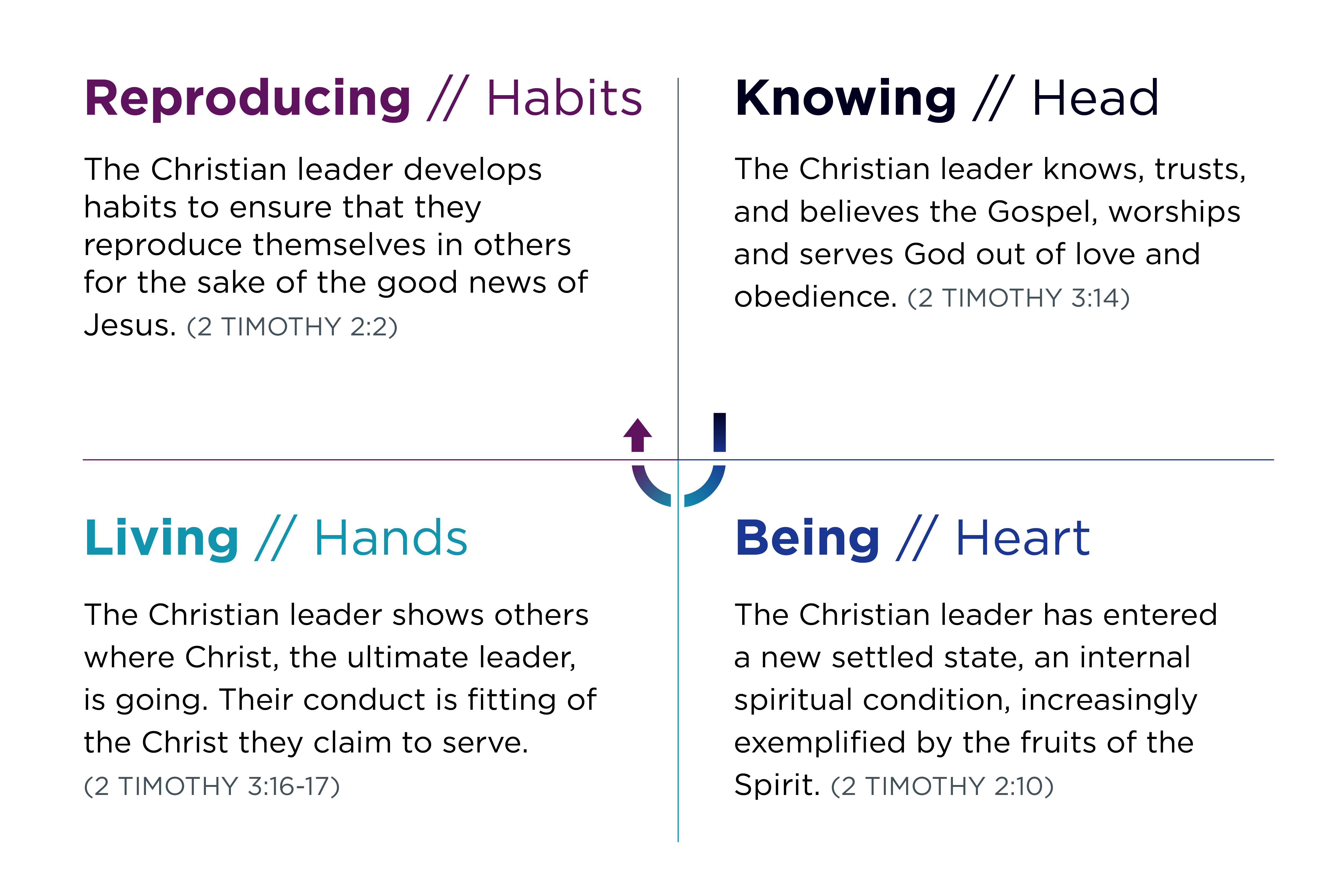Virtual
Big Idea
The Christian leader’s lifestyle is based upon an inner character of the heart, enabled by the Holy Spirit, that causes them to behave in certain ways. This temperament is part of “a settled habit of mind,” an inner trait that drives our outward conduct. This settled habit is how the heart, mind, and hands meet to fuel the task of reproducing leaders to fulfill the purpose of Christ in the world.
Over the previous seven days, I suggested that leadership in 2nd Timothy can be summarized under four headings which I’ve called virtues or settled habits of the mind. They are: knowing, being, living, and reproducing.
I suggested cultivating these virtues so that they become settled habits, default motivations if you would, as we battle the temptations of legalism, relativism, consumerism, and authoritarianism that threaten the Christian leader.
No one has these four virtues working in perfect balance. When one area is growing, it is often true that such progress comes at the expense of another area. We are all a work in progress, and the key is to keep working on them, enabled and encouraged by the Spirit’s untiring efforts.
As I said yesterday, two of these virtues relate to the task of discipleship (knowing and being) and two to the task of mission (living and reproducing). I think that breakdown is consistent with Jesus’ instructions to his disciples, known as the Great Commission. In Matthew 28:18-20 Jesus prioritizes discipleship—teaching them to obey what He had told them—and what I’m calling, mission; that is, taking the good news to every tribe, nation, and tongue. The four virtues I’m recommending fit the two functions of leadership Jesus left to the disciples.
I’ve been involved in Christian leadership for over twenty-five years, and I’ve found it difficult to balance both discipleship and mission equally. Overemphasize one, neglect the other, and we don’t really develop the leaders, at least in the Scriptural sense of the term, that Paul wanted Timothy to develop. What we get are leaders who prioritize discipleship or leaders who prioritize mission. The point is, when we don’t get the balance, we are more susceptible to the four temptations I’ve referenced above.
I’ve never intended to overemphasize mission at the expense of discipleship or discipleship at the expense of mission. If I’ve erred on one of these, it’s been prioritizing mission at the expense of discipleship. I am after all, a missionary—someone ministering for Christ in a land that is not my own. Part of my challenge has been that “discipleship” is such a difficult concept to nail down. There are so many components to discipleship that I never truly knew where to begin or how to explain it succinctly. That is, until I started reading 2nd Timothy with these four virtues in mind. As I began to dig deeper into the text, more of the injunctions Paul gave jumped out at me, and it became possible to slot them all into at least one of these virtues.
This simple exercise revealed two things. First, how these four virtues interact with, and even correlate to, each other. They are interrelated. You can’t seek to live like Christ unless you know this Christ and commit to become like Him.
Second, neglect one of these four virtues, and churches and ministries get out of balance. Prioritize one, and we are in danger of leaving a ministry vulnerable to the temptations of the other three.
This simple exercise led to developing a simple two by two matrix, with one virtue, or settled habit of mind, for each quadrant. Two by two’s have become a popular teaching tool of late. I’ve read a number of Christian books over the last few years that utilize a simple two by two to make complex truths simple. A two by two matrix enables us to see two sides of an issue, often leading to paradoxical situations, which can then be explored rather than ignored.[1]
With the theme of discipleship running along the right-hand side and the theme of mission along the left, the leadership matrix flows from top right down the right-hand side. Starting with knowing, moving down to being, then living and ending with reproducing, the matrix can be summed up with head, heart, hands and habits.

The Scriptures referred to in yesterday’s lesson show how easily the book of 2nd Timothy fits this model. It is possible to place every reference in the corresponding quadrant. As we continue our journey through 2nd Timothy, we will unpack each of these virtues (settled habits), drawing out their significance and deeper meaning. Tomorrow, I will take a look at what happens when each quadrant gives in to the aforementioned temptation.
Food for Thought:
As you look at these quadrants and their associated meanings, prayerfully consider which of them you excel in and which you need to develop. Ask God to speak to you through the rest of this journey.
As always, feel free to post any comments and/or questions in the comments section below.
[1] For more on the significance of a 2 by 2 martix see Alex Lowy and Phil Hood, The Power of the 2x2 Matrix: Using 2x2 Thinking to Solve Business Problems and Make Better Decisions, (2004) John Wiley & Sons, Inc.


Leave a Comment